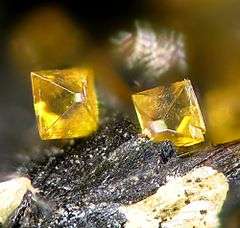Cyrilovite
| Cyrilovite | |
|---|---|
|
Cyrilovite | |
| General | |
| Category | Phosphate mineral |
| Formula (repeating unit) | NaFe3+3(PO4)2(OH)4•2(H2O) |
| Strunz classification | 08.DL.10 |
| Dana classification | 42.07.08.01 |
| Identification | |
| Color | Bright yellow, honey-yellow, orange to brownish yellow, brown |
| Crystal habit | Massive, granular, pseudo cubic, radiating to botryoidal aggregates and crusts |
| Crystal system | Tetragonal - Trapezohedral H-M Symbol (422) Space Group: P 412121,P 432121 |
| Cleavage | None |
| Fracture | Conchoidal |
| Mohs scale hardness | 4 |
| Luster | Vitreous |
| Streak | Yellow |
| Diaphaneity | Translucent |
| Specific gravity | 3.081–3.096 |
| Optical properties | Uniaxial (-) |
| Refractive index | nω = 1.802 - 1.805 nε = 1.769 - 1.775 |
| Birefringence | δ = 0.033 |
| Pleochroism | Weak |
| References | [1][2][3] |
Cyrilovite (NaFe33+(PO4)2(OH)4•2(H2O)) is a hydrous sodium iron phosphate mineral. It is isomorphous and isostructural with wardite, the sodium aluminium counterpart.[4]
Cyrilovite is found in granitic pegmatites.[5] It was first discovered in 1953 in a pegmatite at Cyrilov, near Velké Meźiřiči, West Moravia, Czech Republic.[2]
Composition
The chemical formula of cyrilovite is NaFe3+3(PO4)2(OH)4•2(H2O).[1] Parent phosphate minerals, fluorapatite and triplite-zwieselite, were transformed by hydrothermal alteration and weathering to give a complex, microcrystalline intergrowth of secondary phosphate minerals that include cyrilovite.[6] The sequence of phosphate transformations ended with the formation of cyrilovite within the fluorapatite fractures and the replacement of fluorapatite by lipscombite and crandallite-group minerals.[6] Fransolet suggest that a part of the leached Na leads to the precipitation of cyrilovite, in the fissures cause by the volume decrease resulting from the transformation of typhylite to heteresoite.[5] Mobilization of alkalis and of relatively immobile elements including aluminium and rare earth elements are subsequently incorporated into precipitating cyrilovite, lipscombite and crandallite-group minerals.[6]
The chemical analysis shows substitution not only of Al for Fe, but also of K and Mn for Na, measured and observed specific gravities are considered to be in good agreement.[4] Ferric iron occurs virtually alone in H20 rich minerals such as phosphosiderite, and coupled with Na, K, or Ca in cyrilovite.[5] It is soluble in hot dilute HCl, in hot dilute H2SO4, and, with difficulty, in hot dilute HNO3.[4] In the closed tube, it gives off water and fuses.[4]
Geologic occurrence
The mineral wardite is capable of crystallizing in a similar form to that of cyrilovite because of their closely related chemical compositions. Between wardite’s composition, NaAl3(PO4)2(OH)4•2(H2O), and cyrilovite’s composition, NaFe3(PO4)2(OH)4•2(H2O), they’re able to form end members of a series of solid solutions. Either of the two minerals can occur in various proportions in a series of solid solutions in the wardite mineral group. Cyrilovite is a rare accessory mineral in some oxidizing phosphate-bearing granite pegmatitles and iron deposits. The sequence of phosphate transformations ended with the formation of cyrilovite within the F-apatite factures and the replacement of F-apatite by lipscombite and crandillite-group minerals.[6] Weathering related cyrilovite, lipscombite, and crandillite-group minerals were formed by percolating meteoric waters under increasing oxygen fugacity.[6]
Structure
The crystal structures of natural wardite and of the isomorphous cyrilovite have the space group P41212, Z=4). Hydrogen atoms were not located, but reasonable positions can be estimated. The cell dimentsions of cyrilovite are: c=19.4, a=7.32 Å.[4]
The individual crystals are usually smaller than 0.1 mm and many of them are intergrown. Crystals are squat and when single tend to lie on the basal pinacoid. The pinacoid {001} and the dipyramid {113} are the dominant forms; all the faces of thse forms tend to be present and equally well developed. The dipyramid {012} is not always present. The direction for the a-axis is at 45° angle to the smallest primitive unit cell.[4]
Physical properties
Cyrilovite is a vitreous translucent mineral that can appear in colors ranging from a bright yellow, honey-yellow, orange to brownish yellow, or brown and it has a hardness of 4. It has a yellow streak. The mineral is classified under the space group P41212 and is tetragonal.[1]
References
- 1 2 3 http://rruff.geo.arizona.edu/doclib/hom/cyrilovite.pdf Handbook of Mineralogy
- 1 2 http://www.mindat.org/min-1206.html Mindat.org
- ↑ http://webmineral.com/data/Cyrilovite.shtml Webmineral data
- 1 2 3 4 5 6 Lindberg, M.L. (1957) Relationship of the minerals avelinoite, cyrilovite, and wardite. American Mineralogist, 42, 204-213
- 1 2 3 Fransolet, A.M., Cooper, M.A., Cerny, P., Hawthorne, C., Chapman, R. (2000) The tanco pegmatite at Bernic Lake, Southeastern Manitoba. The Canadian Mineralogist, 38, 893-898
- 1 2 3 4 5 Lottermoser, B., Lu, J. (1997) Petrogenesis of rare-element pegmatites in the Olary Block, South Australia .1. Mineralogy and chemical evolution. Mineralogy & Petrology, 59, 1-19
- Breitinger, D.K., et al. (2004) Combined vibrational spectra of natural wardite. Journal of Molecular Structure, 706, 95-99.
- Cooper, M., Hawthorne, F.C., Cerny, P. (2000) Refinement of the crystal structure of cyrilovite from cyrilov, western Moravia, Czech Republic. Journal of Czech Geological Society, 45, 95-100.
